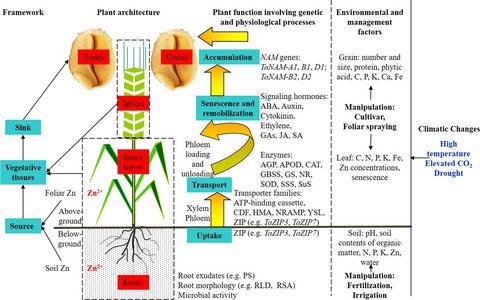当前位置:
X-MOL 学术
›
Food Energy Secur.
›
论文详情
Our official English website, www.x-mol.net, welcomes your feedback! (Note: you will need to create a separate account there.)
Elucidating the source–sink relationships of zinc biofortification in wheat grains: A review
Food and Energy Security ( IF 5 ) Pub Date : 2020-08-19 , DOI: 10.1002/fes3.243 Haiyong Xia 1, 2 , Lan Wang 1, 2 , Yuetong Qiao 1, 2 , Weilin Kong 1 , Yanhui Xue 1 , Zongshuai Wang 1 , Lingan Kong 1 , Yanfang Xue 3 , Tom Sizmur 4
Food and Energy Security ( IF 5 ) Pub Date : 2020-08-19 , DOI: 10.1002/fes3.243 Haiyong Xia 1, 2 , Lan Wang 1, 2 , Yuetong Qiao 1, 2 , Weilin Kong 1 , Yanhui Xue 1 , Zongshuai Wang 1 , Lingan Kong 1 , Yanfang Xue 3 , Tom Sizmur 4
Affiliation

|
Zinc (Zn) concentration in wheat grains is generally low, with an average value of around 28–30 mg/kg. Therefore, increasing wheat grain Zn concentration for better human health is the focus of HarvestPlus global initiatives. Source–sink interactions have been intensively studied for decades to enhance crop yield potential, but less on grain nutritional quality. This review applies concepts of source, sink, and their interactions to the study of wheat grain Zn nutrition and biofortification. Increasing Zn sources to wheat (via soil and foliar application) could directly enlarge available Zn in vegetative tissues and grain Zn sink. Rational nitrogen (N) supply increases grain Zn accumulation (N‐Zn synergism), but phosphorus (P) input generally decreases (P‐Zn antagonism), and the potassium (K) effect is unclear. Conventional and genetic breeding have potential to stimulate Zn flow from source to sink (uptake from soil, root‐to‐shoot translocation, and remobilization). However, a rational manipulation to establish a well‐coordinated source–sink relationship is required to finally realize the grain Zn target (40–50 mg/kg) and increase on‐farm crop yield. Future studies should focus more on fertilization modes adopted by farmers (uses of compound, slow/controlled release, and organic and microbial fertilizers) and develop integrated agronomic and genetic strategies for Zn biofortification. A highly systematic and mechanistic model includes (a) migration paths of Zn (particularly from leaves to different grain parts) using isotopic labeling methods, (b) cross‐talks between Zn and carbon, N, P, K, or other divalent cations, (c) inherent physiological and biochemical processes of enzymes and signaling phytohormones, and (d) complex genetic systems governing Zn homeostasis and their relationships with other nutrients, signaling molecules, and increase or dilution/penalty of yield under different environmental conditions (soil, water, and future climatic changes) and managements (breeding and fertilization). These aspects require further elucidation to fully unravel the “black box” of Zn flow from source to sink.
中文翻译:

阐明小麦籽粒中锌强化的源库关系:综述
小麦籽粒中的锌(Zn)浓度通常较低,平均值约为28–30 mg / kg。因此,增加小麦籽粒锌的浓度以改善人体健康是HarvestPlus全球计划的重点。数十年来,对源-库之间的相互作用进行了深入研究,以提高农作物的增产潜力,但对谷物的营养质量影响较小。本文将源,库及其相互作用的概念应用于小麦籽粒锌营养和生物强化的研究。增加小麦中的锌源(通过土壤和叶面施用)可以直接增加植物组织和籽粒锌库中的有效锌。合理的氮(N)供应增加了谷物的锌积累(N-Zn协同作用),但磷(P)的输入通常会减少(P-Zn拮抗作用),钾(K)的作用尚不清楚。常规育种和遗传育种有可能刺激锌从源头流到汇(从土壤中吸收,从根到茎的转运和迁移)。但是,要最终实现籽粒锌的目标(40-50 mg / kg)并增加农作物的产量,就需要采取合理的措施来建立良好的源库关系。未来的研究应更多地关注农民采用的施肥方式(使用复合肥,缓释/控释以及有机和微生物肥料),并开发用于锌生物强化的综合农艺和遗传策略。高度系统化和机械化的模型包括(a)使用同位素标记法的Zn迁移路径(特别是从叶子到不同谷物部分的迁移),(b)Zn与碳,N,P,K或其他二价阳离子之间的串扰,(c)酶和信号植物激素的固有生理和生化过程,以及(d)控制锌稳态及其与其他营养素,信号分子的关系的复杂遗传系统,以及在不同环境条件(土壤,水)下产量的增加或稀释/损失,以及未来的气候变化)和管理(育种和施肥)。这些方面需要进一步阐明,以完全弄清从源头到汇点的锌流的“黑匣子”。
更新日期:2020-08-19
中文翻译:

阐明小麦籽粒中锌强化的源库关系:综述
小麦籽粒中的锌(Zn)浓度通常较低,平均值约为28–30 mg / kg。因此,增加小麦籽粒锌的浓度以改善人体健康是HarvestPlus全球计划的重点。数十年来,对源-库之间的相互作用进行了深入研究,以提高农作物的增产潜力,但对谷物的营养质量影响较小。本文将源,库及其相互作用的概念应用于小麦籽粒锌营养和生物强化的研究。增加小麦中的锌源(通过土壤和叶面施用)可以直接增加植物组织和籽粒锌库中的有效锌。合理的氮(N)供应增加了谷物的锌积累(N-Zn协同作用),但磷(P)的输入通常会减少(P-Zn拮抗作用),钾(K)的作用尚不清楚。常规育种和遗传育种有可能刺激锌从源头流到汇(从土壤中吸收,从根到茎的转运和迁移)。但是,要最终实现籽粒锌的目标(40-50 mg / kg)并增加农作物的产量,就需要采取合理的措施来建立良好的源库关系。未来的研究应更多地关注农民采用的施肥方式(使用复合肥,缓释/控释以及有机和微生物肥料),并开发用于锌生物强化的综合农艺和遗传策略。高度系统化和机械化的模型包括(a)使用同位素标记法的Zn迁移路径(特别是从叶子到不同谷物部分的迁移),(b)Zn与碳,N,P,K或其他二价阳离子之间的串扰,(c)酶和信号植物激素的固有生理和生化过程,以及(d)控制锌稳态及其与其他营养素,信号分子的关系的复杂遗传系统,以及在不同环境条件(土壤,水)下产量的增加或稀释/损失,以及未来的气候变化)和管理(育种和施肥)。这些方面需要进一步阐明,以完全弄清从源头到汇点的锌流的“黑匣子”。


























 京公网安备 11010802027423号
京公网安备 11010802027423号